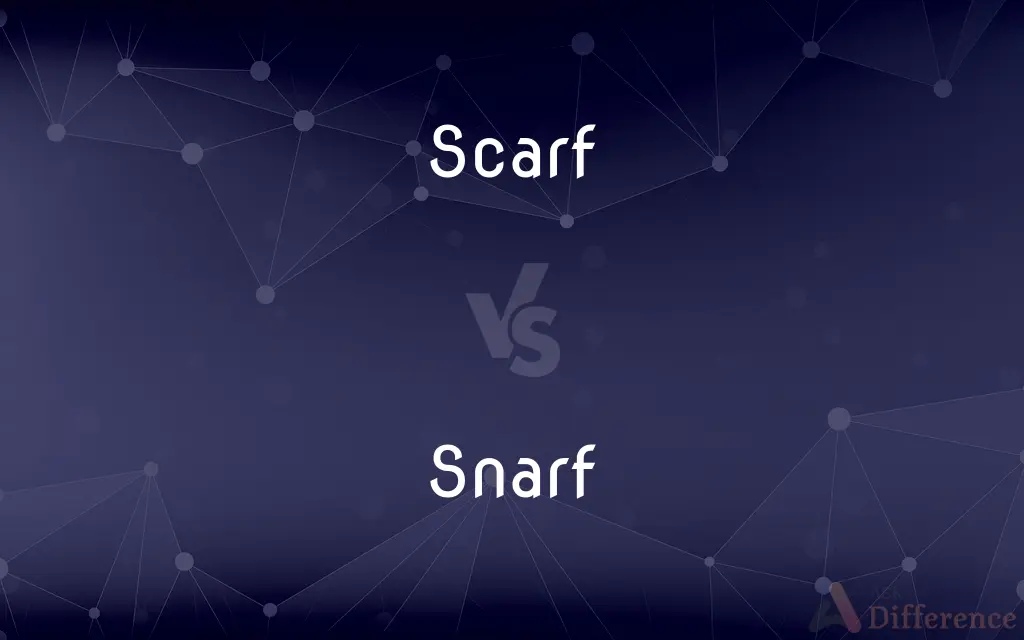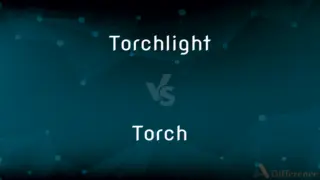Scarf vs. Snarf — What's the Difference?
By Fiza Rafique & Urooj Arif — Updated on March 27, 2024
Scarf refers to a piece of fabric worn for warmth or fashion, while snarf implies eating quickly or greedily, highlighting their distinct uses in language.

Difference Between Scarf and Snarf
Table of Contents
ADVERTISEMENT
Key Differences
A scarf is a length of fabric worn around the neck, head, or shoulders, often for warmth, cleanliness, fashion, or religious reasons. It can be made from various materials like wool, cotton, silk, or synthetic fibers and comes in numerous designs and patterns. On the other hand, snarf is a colloquial term used to describe the act of eating or drinking something in a hurried or greedy manner. It often conveys a sense of urgency or a lack of manners and is usually used informally.
Scarves serve multiple purposes beyond their primary function of providing warmth. They can be fashion accessories, adding color and style to an outfit, or serve practical functions such as protection from the sun or dust. Conversely, snarfing is generally not seen in a positive light, as it suggests eating quickly without savoring the food, possibly leading to overeating or indigestion.
While the scarf is a tangible item with a history that dates back to ancient civilizations, used for cleanliness, status, and uniformity, snarfing is a behavior often associated with modern eating habits. The term "snarf" might be used humorously or light-heartedly to describe someone's quick consumption of food or drink, especially in casual settings or among friends.
The use of scarves varies widely around the world, influenced by culture, climate, and personal preference. They can signify religious adherence, cultural identity, or social status. Snarfing, in contrast, is a universal behavior not bound by cultural norms, though the term itself is primarily used in English-speaking contexts.
Despite their differences, both terms are deeply embedded in everyday language, each evoking a distinct set of images and associations: one of style, comfort, and utility, and the other of haste, appetite, and sometimes humor.
ADVERTISEMENT
Comparison Chart
Definition
A piece of fabric worn for warmth, cleanliness, or fashion.
Eating or drinking quickly or greedily.
Purpose
Warmth, fashion, protection, cultural identity.
Satisfying hunger or thirst rapidly.
Context
Fashion, clothing, accessories.
Informal, colloquial speech.
Connotations
Style, elegance, comfort, cultural significance.
Hurried eating, lack of manners, informality.
Varieties
Wool, silk, cotton, synthetic; various designs.
N/A
Compare with Definitions
Scarf
Can be made from a variety of materials.
His silk scarf added a touch of elegance to his outfit.
Snarf
Often implies eating without proper manners.
She snarfed her lunch while running to her next meeting.
Scarf
A fashion accessory in many cultures.
The brightly colored scarf became the centerpiece of her ensemble.
Snarf
To eat or drink something quickly and greedily.
He snarfed down the pizza before anyone else could get a slice.
Scarf
Used for practical and religious reasons.
She wears a scarf for religious observance.
Snarf
Can suggest a humorous or light-hearted tone.
He jokingly warned others not to snarf his share of the cake.
Scarf
Offers protection from the sun and dust.
They used scarves to protect their faces from the desert dust.
Snarf
Used informally among friends or in casual settings.
We all snarfed our burgers after the game.
Scarf
A piece of cloth worn around the neck for warmth or fashion.
She wrapped a woolen scarf tightly against the cold.
Snarf
Sometimes associated with hurried or busy lifestyles.
Busy mornings often mean snarfing breakfast on the way out.
Scarf
A scarf, plural scarves, is a piece of fabric worn around the neck or head for warmth, sun protection, cleanliness, fashion, or religious reasons or used to show the support for a sports club or team. They can be made in a variety of different materials such as wool, linen, silk or cotton.
Snarf
To eat or drink rapidly or eagerly; devour
Snarfed down some cookies.
Scarf
A length or square of fabric worn around the neck or head
A silk scarf
She tucked her woolly scarf around her neck
Snarf
To eat or consume greedily.
He snarfed a whole bag of chips in a couple of minutes!
Scarf
A joint connecting two pieces of timber or metal in which the ends are bevelled or notched so that they fit over or into each other.
Snarf
To take something by dubious means, but without the connotations of stealing; to take something without regard to etiquette.
I snarfed a bunch of freebies from the vendor's booth when he wasn't looking.
Scarf
An incision made in the blubber of a whale.
Snarf
To slurp (computing slang sense); to load in entirety; to copy as a whole.
I snarfed the whole database into my program.
Scarf
Join the ends of (two pieces of timber or metal) by bevelling or notching them so that they fit over or into each other
He forced me to scarf the keel timbers in watertight sections
The scarfing follows the natural grain of the wood
Snarf
Make off with belongings of others
Scarf
Make an incision in the blubber of (a whale).
Scarf
Eat or drink (something) hungrily or enthusiastically
He scarfed down the waffles
Scarf
A long piece of cloth worn about the head, neck, or shoulders.
Scarf
A decorative cloth for covering the top of a piece of furniture; a runner.
Scarf
A sash indicating military rank.
Scarf
A joint made by cutting or notching the ends of two pieces correspondingly and strapping or bolting them together. Also called scarf joint.
Scarf
Either of the correspondingly cut or notched ends that fit together to form such a joint.
Scarf
To dress, cover, or decorate with or as if with a scarf.
Scarf
To wrap (an outer garment) around one like a scarf.
Scarf
To join by means of a scarf.
Scarf
To cut a scarf in.
Scarf
To eat or drink voraciously; devour
"Americans scarf down 50 million hot dogs on an average summer day" (George F. Will).
Scarf
A long, often knitted, garment worn around the neck.
Scarf
A headscarf.
Scarf
(dated) A neckcloth or cravat.
Scarf
A type of joint in woodworking.
Scarf
A groove on one side of a sewing machine needle.
Scarf
A dip or notch or cut made in the trunk of a tree to direct its fall when felling.
Scarf
(Scotland) A cormorant.
Scarf
To throw on loosely; to put on like a scarf.
Scarf
To dress with a scarf, or as with a scarf; to cover with a loose wrapping.
Scarf
To shape by grinding.
Scarf
To form a scarf on the end or edge of, as for a joint in timber, forming a "V" groove for welding adjacent metal plates, metal rods, etc.
Scarf
To unite, as two pieces of timber or metal, by a scarf joint.
Scarf
To eat very quickly.
You sure scarfed that pizza.
Scarf
A cormorant.
Scarf
An article of dress of a light and decorative character, worn loosely over the shoulders or about the neck or the waist; a light shawl or handkerchief for the neck; also, a cravat; a neckcloth.
Put on your hood and scarf.
With care about the banners, scarves, and staves.
Scarf
In a piece which is to be united to another by a scarf joint, the part of the end or edge that is tapered off, rabbeted, or notched so as to be thinner than the rest of the piece.
Scarf
To throw on loosely; to put on like a scarf.
Scarf
To dress with a scarf, or as with a scarf; to cover with a loose wrapping.
Scarf
To form a scarf on the end or edge of, as for a joint in timber, metal rods, etc.
Scarf
A garment worn around the head or neck or shoulders for warmth or decoration
Scarf
A joint made by notching the ends of two pieces of timber or metal so that they will lock together end-to-end
Scarf
Masturbate while strangling oneself
Scarf
Unite by a scarf joint
Scarf
Wrap in or adorn with a scarf
Common Curiosities
What does it mean to snarf food?
To snarf food means to eat it quickly and greedily, often without proper manners.
How do scarves signify cultural identity?
Scarves can signify cultural identity through specific patterns, materials, or ways of wearing them unique to a culture.
What materials are scarves made from?
Scarves can be made from wool, cotton, silk, synthetic fibers, and more, depending on their intended use.
Can scarves be worn all year round?
Yes, scarves can be worn all year, with lighter materials like silk or cotton for warmer seasons and wool for colder times.
What is a scarf used for?
A scarf is used for warmth, fashion, cleanliness, protection, or religious reasons.
Is snarfing considered rude?
Snarfing is generally considered informal and might be viewed as rude in formal dining settings.
Can anyone wear a scarf?
Yes, scarves are versatile accessories worn by people of all ages and genders.
Why do people snarf food?
People might snarf food due to hunger, lack of time, or in casual settings where fast eating is more acceptable.
Is it okay to snarf food?
While snarfing is acceptable in casual or personal settings, it's best to eat mindfully and respectfully in social or formal situations.
How do you choose a scarf for an outfit?
Choosing a scarf for an outfit depends on the color, pattern, material, and the overall look you're aiming for.
Does snarfing affect digestion?
Eating too quickly, or snarfing, can lead to indigestion and may diminish the enjoyment of food.
Are there any famous designs of scarves?
Yes, brands like Hermès are renowned for their high-quality silk scarves with distinctive designs.
Can scarves be DIY projects?
Absolutely, making scarves can be a fun and rewarding DIY project, allowing for personalized designs and materials.
Is snarfing a new term?
Snarfing is relatively modern and colloquial, used more in informal speech than formal writing.
What is the history of the scarf?
The scarf has a rich history, dating back to ancient civilizations where it was used for warmth, cleanliness, and as a status symbol.
Share Your Discovery

Previous Comparison
Torchlight vs. Torch
Next Comparison
Solvent vs. VehicleAuthor Spotlight
Written by
Fiza RafiqueFiza Rafique is a skilled content writer at AskDifference.com, where she meticulously refines and enhances written pieces. Drawing from her vast editorial expertise, Fiza ensures clarity, accuracy, and precision in every article. Passionate about language, she continually seeks to elevate the quality of content for readers worldwide.
Co-written by
Urooj ArifUrooj is a skilled content writer at Ask Difference, known for her exceptional ability to simplify complex topics into engaging and informative content. With a passion for research and a flair for clear, concise writing, she consistently delivers articles that resonate with our diverse audience.















































